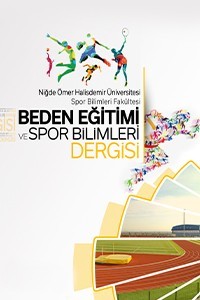BUZ HOKEYİ OYUNCU VE ANTRENÖRLERİNİN SAĞLIK-EGZERSİZ / FİZİKSEL AKTİVİTE DÜZEYLERİNİN BELİRLENMESİ
Amaç: Bu çalışmanın amacı, buz hokeyi oyuncu ve antrenörlerinin sağlıkegzersiz/fiziksel aktivite alışkanlıkları ve bilinç düzeylerinin belirlenmesidir. Yöntem: Bu amaç doğrultusunda, araştırıcılar tarafından geliştirilen 82 maddelik 31’i kişisel bilgilere, 51’i egzersiz bilinç düzeyine yönelik bir anket ilgili antrenör ve sporculara n= 66 uygulanmıştır. Katılımcılar 2008 yılı 18 yaş altı Dünya Buz Hokeyi Şampiyonasına katılan antrenör n= 7 ve sporculardır n= 59 . Elde edilen veriler betimsel tanımlayıcı istatistikler ve ülkeler açısından yapılan karşılaştırmaları elde etmek için istatistik paket programı kullanılarak analiz edilmiştir. Bulgular: Oyuncuların sağlık-egzersiz/fiziksel aktivite bilinç düzeylerinde ülkeler açısından önemli bir farklılık olduğu görülmüştür [x2 4 = 28,23, p
Anahtar Kelimeler:
Sağlık, egzersiz/fiziksel aktivite alışkanlığı, buz hokeyi, antrenör, oyuncu
THE HEALTH-EXERCISE/PHYSICAL ACTIVITY LEVELS OF THE ICE HOCKEY PLAYERS AND COACHES
Objective: The purpose of this study was to determine the health-exercise/physical activity habits and consciousness level of ice hockey players and coaches. Methods: For this purpose, an 82 item questionnaire 31 of these items were related with personal information and health-exercise/physical activity habits, 51 of them were related with exercise consciousness levels developed researcher was given to the players and coaches. n=66 . Participants were ice hockey players n=59 and coaches n=7 who participated in World Championships under age of 18 in 2008. The obtained data was analyzed by using the statistical package in order to get descriptive statistics and also comparisons were made in terms of country. Results: It was seen that players’ exercise/physical activity consciousness levels were significantly different in terms of country [x2 4 =28,23, p
Keywords:
Health, exercise/physical activity habit, ice hockey players, coaches,
___
- Askegaard ML. The impact of college wellness course on wellness knowledge, attitude and behavior. The University of North Dakota, unpublished PhD thesis. 2000.
- Benzer JR., Adams TB, Steinhardt M.A. Relationship of body dissatisfaction to physical health and wellness. American Journal of Health Behavior, 1997; 2: 21.
- Brylinksy J., Hoadley M.A Comparative analysis of wellness attitudes of “suicidal” and “at risk” college students. Wellness Perspectives, 1991: 7(2): 59-72.
- Cagle BA survey of status of the life a time wellness course in Tennessee, DA. Middle Tennessee State University unpublished PhD thesis. 2000.
- Canetti L.,Bacher E. Parental bonding and mental health in adolescence. Adolescence 1997: 32(126):381-394.
- Cramer S.R., Nieman D.C, Lee JW. The effects of moderate exercise training on psychological well-being: mood state in women. Journal of Psychosomatic Research 1991: 35(4-5) : 437-449.
- Epstein J.A., Griffin K.W, Gilbert J.B Positive impact of competence skills and psychological wellness in protecting inner-city adolescents from alcohol use. Prevention Science 2002: 3(2): 95-104.
- Fişek, N. Halk Sağlığına Giriş, Ankara : H. Ü. Dünya Sağlık Örgütü Hizmet Araştırma ve Araştırıcı Yetiştirme Merkezi Yayını No. 2, Çağ Matbaası.: 1985.
- Garrett M T. Soaring on the wings of the eagle: wellness of native American high school students. Professional School Counseling 1999: 3(1): 57-64.
- Koçoğlu, F. Dünyada ve Türkiye’de sağlık. Sivas Cumhuriyet Üniversitesi Yayınları, No: 72 :1998.
- Sweeney T.J., Witmer J.M. Beyond social interest: striving toward optimum health and wellness. Psychology 1991: 47(4): 527-540.
- Atomi A, Miyashita M Influences of weight reduction and aerobic power and body composition of middle-aged women. J. Sports Med.1987:501-8.
- Evans W.J., Campbell W.W. Sarkopenia and age-related changes in body composition and functional capacity. American Inst. Nutr 1993: 123: 465-468.
- Heyward U.H. Advanced fitness assessment and exercise prescription. Champaign, Human Kinetic Books:1991.
- Jackson A.S., Pollack M.L., Ward A. Generalized equations for predicting body density of women. Med. Sci. Sports Exercise 1980: 390-393.
- Kenayias J.J. Aging body composition: possibilities for future studies. American Inst. Nutr. 1993: 123: 454-458.
- Klesges RC Physical activity, body composition and blood pressure: a multimethod approach. Med. Sci. Sports exercise 1991: 759-765.
- Stokes R., Moore A.C, Moore C. Fitness, the new wave. North Carolina, Hunter textbooks inc.:1986.
- Vander A.J, Sherman J.H., Luciano D.S. Human physiology, New York, Mc Graw Hill: 1990.
- ISSN: 1307-6477
- Yayın Aralığı: Yılda 3 Sayı
- Başlangıç: 2007
- Yayıncı: Niğde Ömer Halisdemir Üniversitesi
Sayıdaki Diğer Makaleler
Hüseyin KIRIMOĞLU, Yunus YILDIRIM, Ali TEMİZ
HALTERCİLERİN KİŞİLİK ÖZELLİKLERİNİN FARKLI DEĞİŞKENLERE GÖRE İNCELENMESİ
BUZ HOKEYİ OYUNCU VE ANTRENÖRLERİNİN SAĞLIK-EGZERSİZ / FİZİKSEL AKTİVİTE DÜZEYLERİNİN BELİRLENMESİ
Semiyha Dolaşır TUNCEL, Fehmi TUNCEL
DAĞCILIK SPORUYLA UĞRAŞAN BİREYLERİN BU SPORA YÖNELME NEDENLERİ ÜZERİNE BİR ARAŞTIRMA
Sümmani EKİCİ, Tekin ÇOLAKOĞLU, Akan BAYRAKTAR
Cengiz ARSLAN, Mehmet GÜLLÜ, Varol TUTAL
NEGATİF DUYGUSALLIĞIN STRES ÜZERİNDEKİ ETKİSİ: FAAL FUTBOL HAKEMLERİ ÜZERİNDE BİR ARAŞTIRMA
